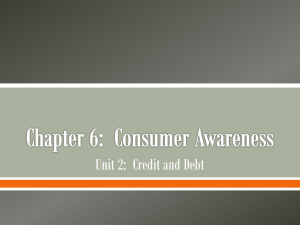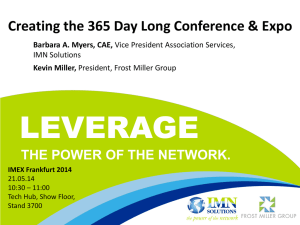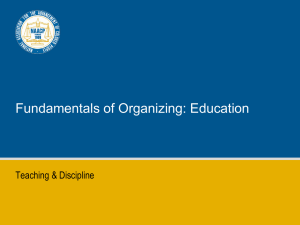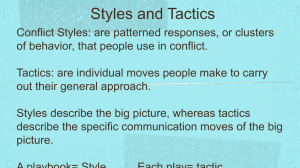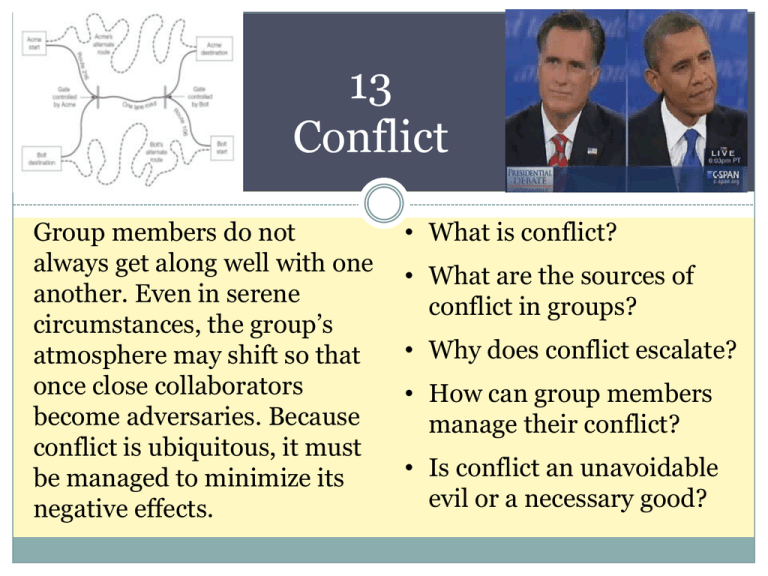
13
Conflict
Group members do not
always get along well with one
another. Even in serene
circumstances, the group’s
atmosphere may shift so that
once close collaborators
become adversaries. Because
conflict is ubiquitous, it must
be managed to minimize its
negative effects.
• What is conflict?
• What are the sources of
conflict in groups?
• Why does conflict escalate?
• How can group members
manage their conflict?
• Is conflict an unavoidable
evil or a necessary good?
Causes
Escalation
Resolution
Winning
Uncertainty
Commitment
Negotiation
Sharing
Misperception
Perception
Understanding
Controlling
Soft tactics
Hard
tactics
Cooperative
tactics
Working
Retaliation
Reciprocity
Forgiveness
Liking
Irritation
Anger
Composure
Few
Many
Few
Some people are always
That man is an aggressive
creature will hardly be
disputed. With the
exception of certain
rodents, no other
vertebrate habitually
distroys members of his
own species.
A. Storr
If you have learned how
to disagree without
being disagreeable, then
you have discovered the
secret of getting along -whether it be business,
family relations, or life
itself.
Bernard Meltzer
itching for a fight.
Groups must experience
conflict to develop fully.
The human species is, by
nature, aggressive.
An all-male group will have
higher levels of conflict than
will an all-female group.
The best way to deal with
conflict is to talk things over.
What is Conflict?
Definition: Disagreement,
discord and friction that
occur when the actions or
beliefs of one or more
members of the group are
unacceptable to and are
resisted by one or more of
the other group members
Conflict
escalation
Conflict
de-escalation
Conflict
Disagreement
Routine
interaction
Conflict
resolution
The Roots of
Conflict
Process
Issue
Dynamics
Winning
Who has won?
Conflict and
competition
Sharing
Who gets what?
Resource distribution
Controlling Who is in charge? Power struggles
Working
Who decides?
Liking and
Disliking
Who do I like?
Task and process
conflict
Personal differences
Conflict and
competition
Winning
Deutsch:
Cooperation
vs.
competition
Mixed-motive
conflict and
the
prisoner’s
dilemma
game (PDG)
John’s Choice
D
C
John
John
C
Steve’s Choice
Steve
Wins
Wins
25¢
25¢
Steve
Loses
Steve
Wins
50¢
50¢
25¢
John
John
D
Wins
Loses
25¢
Steve
Loses
10¢
Loses
10¢
Prisoner’s Dilemma Game
John’s Choice
C
Steve’s Choice
C
D
Steve
John
John
Wins
Wins
25¢
Steve
Wins
Loses
25¢
25¢
Steve
D
50¢
John
John
Loses
Loses
25¢
Steve
Wins
Loses
50¢
10¢
10¢
If John picks C, and
Steve picks C
If John picks D, and
Steve picks C
If John picks C, and
Steve picks D
If John picks D, and
Steve picks D
Factors that influence
PDG choices
Wall Street v. Community Game
Opponent vs. Partner
Iterated cooperation
Reciprocity over iterations
Amount of money
Sex differences
Cooperative Classrooms
Some game shows,
such as “friend or
foe,” use
the PDG
Social values orientation (SVO)
Individualists
Competitors
Proself and concerned only with
their own outcomes. They make
decisions based on what they
think they personally will
achieve, without concern for
others’ outcomes.
Proself but not prosocial they
maximize their own outcomes
and minimize others’ outcomes.
They view disagreements as
win–lose situations and find
satisfaction in forcing their ideas
on others.
Social Values
Orientation
Altruists
Cooperators
Prosocial but not proself, so they
are motivated to help others who
are in need. They willingly
sacrifice their own outcomes in
the hopes of helping others
achieve some gain.
Prosocial and proself, they strive
to maximize their own outcomes
and others’ outcomes as well.
They value accommodative
interpersonal strategies that
generate win–win situations.
Sharing
Groups, because
they ask individuals
to work, live, and
play with others, can
set the stage of
conflict over
resources, and how
they will be shared
Social Dilemmas
Commons Dilemma (social traps):
exploiting shared resources
Public goods dilemmas:
contributions to public goods (freeriding)
Fairness dilemmas: distributive vs.
procedural justice, distribution norms
Responsibility dilemmas:
egocentrism vs. sociocentrism
Controlling
Conflict can, in
many cases, be
traced to status
differentiation
processes, as group
members seek to:
Influence each
other
Gain positions of
authority within
the group
Morrill (1995) confirmed
the image of companies as
arenas for power struggles,
when group members
compete with each other
for power, promotions, and
prominence, often by using
manipulative, illicit tactics
Ambush: a covert action to
inconvenience an adversary
Blindsiding: an intentional and
surprising public embarrassment of
an executive
Meltdown: a physical fight between
executives”
Working: Task and
Process Content
Task Conflict
• Disagreements over issues that are
relevant to the group’s recognized goals
and procedures
Process Conflict
• Disagreement over the methods the
group should use to complete its basic
tasks
Personal Conflict
• Interpersonal discord that occurs
because members dislike each other
Rules of Order seek
to miminize process
conflicts
Note: Process and personal
conflict disrupt group
performance, but task
conflict sometimes helps
the group members work
together more effectively.
Liking and Disliking: Personal
and Interpersonal Conflict
Any factor that causes disaffection between group members (e.g., differences in
attitudes, objectionable personal qualities) can increase personal conflict.
Balance theory predicts that
group members will respond
negatively when they disagree
with those they like or agree
with those they dislike, but as
Taylor’s work confirmed,
conflict is greatest when group
members both disagree with
and dislike each other.
Causes
Escalation
Commitment
Uncertainty
Misperception
Perception
Hard
Softtactics
tactics
Retaliation
Reciprocity
Anger
Irritation
Many
Few
Resolution
As conflicts
escalate, group
members’
doubts and
uncertainties are
replaced by a
firm
commitment to
their position.
Perception Misperception
During
conflict
people’s
perception of
the sitaution
and the people
in that
situation tend
to be so
distorted that
they inflame
rather than
smooth
conflict
Misattribution and
FAE
Misunderstanding
motivations
Soft Tactics Hard Tactics
As conflict
intensifies,
people shift
from easygoing
influence
methods to
tougher
strategies.
Pruitt and his colleagues demonstrated this
tendency in their study of “persistent
annoyance”.
Soft Tactics Hard Tactics
Deutsch and
Krauss studied
how people
react to
competitive
circumstances
in their classic
Trucking
Game
Experiment
Reciprocity Retaliation
The Norm of Reciprocity suggests: Pay back
favors with rewards, but if harmed: retaliate
Person A
inflicts
-1 harm
B pays back
with -2 harm
Person A
pays back
-2 harm
B answers
with -3 harm
Person A
inflicts
-4 harm
Irritation Anger
Irritated people often display the
emotion anger, but the emotion can
trigger all manner of negative
interpersonal behaviors, including the
rejection of concessions, the tendering
of unworkable initial offers, and the use
of contentious influence strategies .
Anger is also often
expressed during
Flaming
online
a computer-mediated
interactions.
communication that the
recipient construes as
hostile, aggressive,
intimidating, insulting,
offensive, or unfriendly.
Few Many
Conflicts are initially localized, but as they escalate more group
members are drawn into the fray as they lend their support to
one or more of the involved parties.
Group members frequently use coalitions to
shift the balance of power in their favor.
Coalitions are often viewed as contentious, heavy-handed
influence tactics because individuals in the coalition work not
only to ensure their own outcomes but also to worsen the
outcomes of non-coalition members. Coalitions form with
people and against other people.
Causes
Escalation
Resolution
Uncertainty
Certainty
Negotiation
Perception
Misperception
Understanding
Soft tactics
Hard tactics
Cooperative
tactics
Reciprocity
Retaliation
Forgiveness
Irritation
Anger
Composure
Few
Many
Few
Commitment Negotiation
Commitment → Negotiation (Getting to Yes)
Types: soft, hard, and principled negotiators
Misperception Understanding
The neural bases
of empathy
Empathy–
recognizing
others thoughts
and emotions –
increases
cooperativeness
and reduces
conflict.
Source: http://onlinelibrary.wiley.com/doi/10.1111/j.1749-6632.2011.06027.x/full
Hard Tactics Cooperative
Tactics
The Dual Concern
Model of Conflict Styles
Other Conflict Resolution
Mechanisms
Retaliation Forgiveness
• Tit-for-Tat is nice, provocable, clear,
forgiving (and reciprocal)
Many Few: Mediation (3rd
party)
• inquisitorial, arbitration, moot
Anger Composure
• Count to ten
• Rethink that email
Does Conflict, When Resolved, Lead to Improved
Group Functioning?
Conflict is a natural consequence of joining a group
Cooperation may promote group unity but more
likely: conflict undermines the group
De Dreu & Weingart find that any type of conflict
(task, process, and relational) undermines group
functioning, but in some cases (when it is not
associated with personal conflict) task conflict may
be a benefit.
Causes
Winning
Sharing
Controlling
Escalation
Resolution
Uncertainty
Certainty
Negotiation
Perception
Misperception
Understanding
Soft tactics
Hard tactics
Cooperative
tactics
Reciprocity
Retaliation
Forgiveness
Irritation
Anger
Composure
Few
Many
Few
Working
Liking



